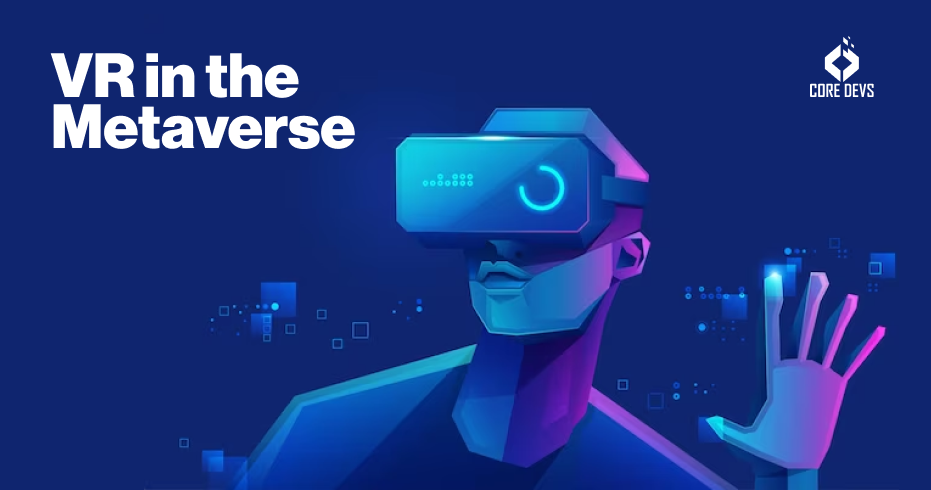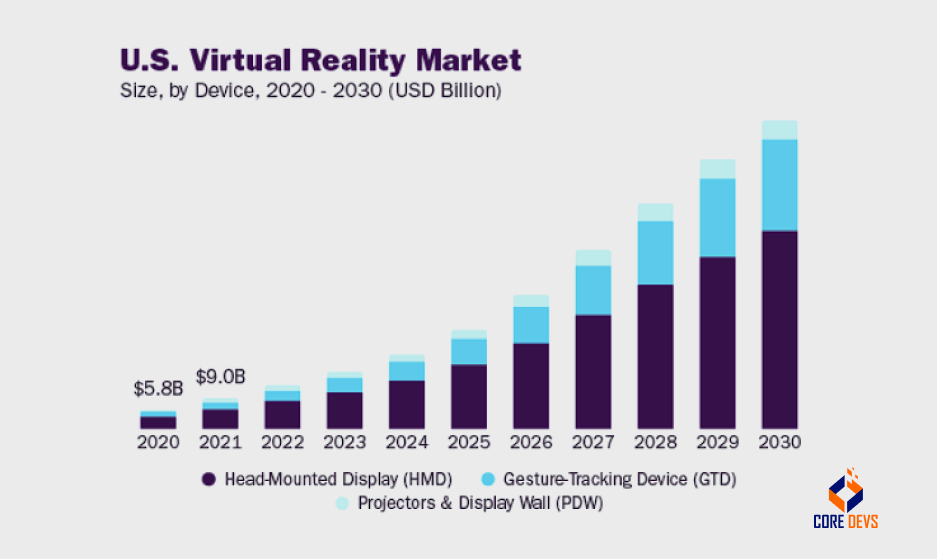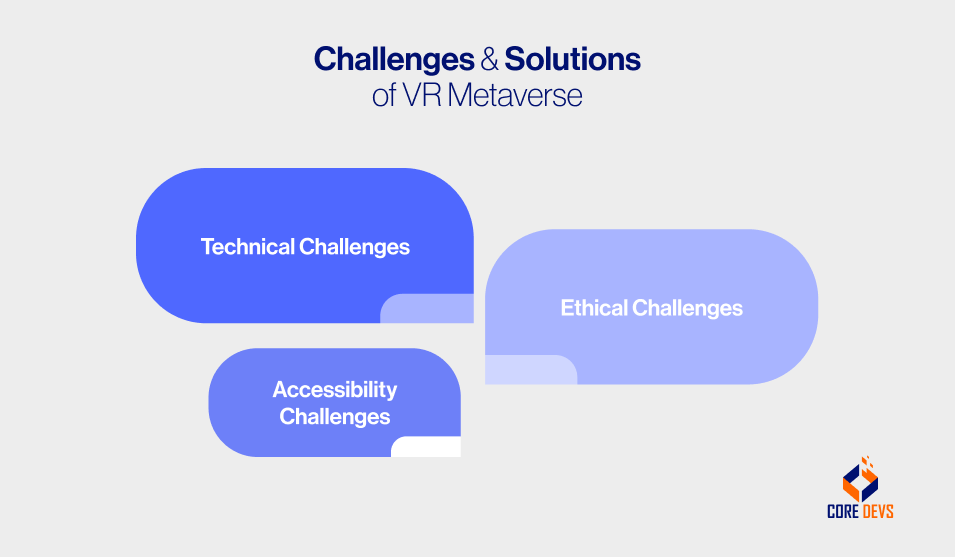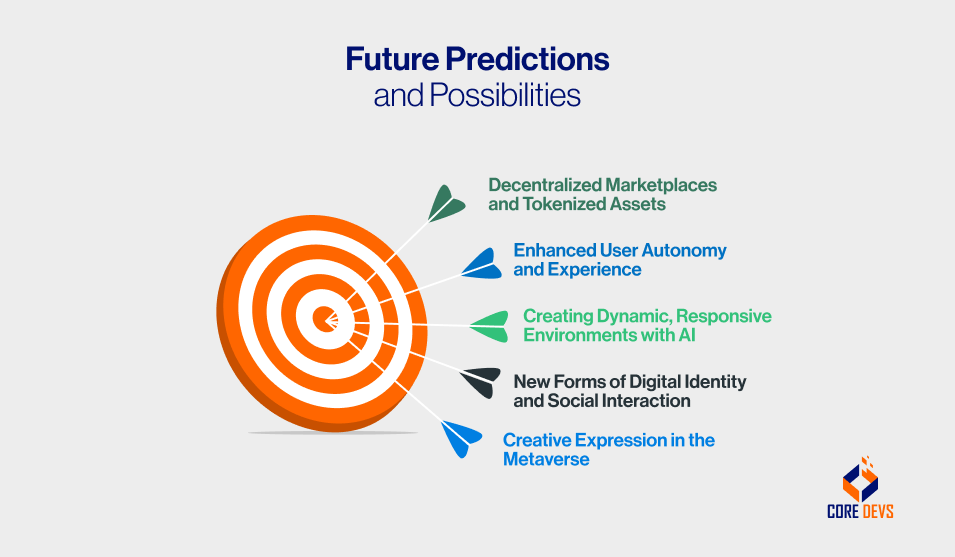If you’re fascinated by the evolving digital landscape, you’ve likely encountered VR (Virtual Reality) and the Metaverse. These technologies are revolutionizing our virtual experiences in unimaginable ways.
But what drives this evolution of the future?
It’s the integration of VR platforms, AR (Augmented Reality), and the expansive Metaverse. Though the concepts may seem intricate, fear not. I’m here to guide you through the thrilling intricacies of VR and the Metaverse, showcasing their impact on our digital interactions.
Let’s dive into the captivating world of VR Metaverse.
What is Metaverse?
The Metaverse is a collective virtual shared space created by the convergence of virtually enhanced physical reality, augmented reality (AR), and the internet.
Imagine a boundless digital universe – that’s the Metaverse. It’s an expansive network of 3D virtual worlds where users interact, play, work, and even trade. This concept often includes virtual reality (VR) elements, where users interact within a computer-generated environment and aspects of the physical world.
This digital cosmos blurs the lines between physical and digital realities, offering an immersive escape into parallel worlds.
Evolution and Current State of Metaverse Technology
The Metaverse isn’t new; its roots trace back to early virtual worlds and online games. However, its recent evolution is phenomenal. With advancements in VR and AR technology, high-speed internet, and more powerful computing, the Metaverse has transformed into a sophisticated, interactive platform.
Today, it’s a bustling ecosystem with virtual economies, social spaces, and innovative experiences. From virtual real estate booms to global social events, the Metaverse is rapidly becoming a significant part of our digital lives.
VR and AR: Pillars of the Metaverse
VR and AR are the twin engines driving the Metaverse. VR immerses users completely in a digital environment, allowing them to live out experiences as if they were real. It’s the gateway to the Metaverse’s deep, immersive worlds.
AR, on the other hand, overlays digital information onto the physical world, enhancing real-life experiences with virtual elements. In the Metaverse, VR brings depth and immersion, while AR brings context and connection to the real world.
Differences and Synergies between VR and AR in the Metaverse Context
While VR and AR have distinct functionalities, their synergy makes the Metaverse extraordinary.
Here is a table that outlines the differences and synergies between Virtual Reality (VR) and Augmented Reality (AR) in the context of the Metaverse:
| Aspect | Virtual Reality (VR) | Augmented Reality (AR) |
| Definition | A simulated experience that can be similar to or completely different from the real world. Uses 3D environments. | An interactive experience where the real-world environment is enhanced with computer-generated perceptual information. |
| Primary Use | Fully immersive experiences, primarily for gaming, simulations, and training. | Overlaying digital information onto the real world, used for information enhancement and interactive experiences. |
| Hardware | Requires headsets like Oculus Rift, HTC Vive, and standalone VR headsets. | Uses devices like smartphones, tablets, AR glasses (e.g., Microsoft HoloLens, Google Glass). |
| User Interaction | User is completely immersed in a virtual environment, often with limited awareness of the real world. | User interacts with both the real world and digital overlays, maintaining awareness of the real environment. |
| Integration with Reality | Creates a completely virtual world, separate from the real world. | Enhances real-world environments with digital elements, maintaining a connection to reality. |
| Applications in Metaverse | Creating fully immersive gaming, socializing, virtual events, and training environments. | Enhancing real-world experiences with digital information, interactive learning, navigation, and mixed reality social interactions. |
Metaverse vs Virtual Reality
The Metaverse and Virtual Reality (VR) are related but distinct concepts. Understanding their differences is key to grasping their unique roles in the digital world.
Here is a table that shows the differences between Metaverse and Virtual Reality:
| Category | Virtual Reality (VR) | Metaverse |
| Definition | VR is a simulated experience that can be similar to or completely different from the real world. It immerses users in a computer-generated environment, enabling them to interact with and explore these virtual spaces. | The Metaverse is an interconnected network of virtual spaces that encompasses various immersive technologies, including VR, AR, and MR, to provide a more expansive and collaborative experience. Numerous projects have showcased the potential of this concept, offering unique features and experiences. |
| Platform Interpretation | VR is primarily experienced through dedicated VR headsets. | The Metaverse can be accessed through a range of devices, including smartphones, tablets, and computers. Here are some of the differences between Metaverse and Virtual Reality: |
| Technological Constraints | VR technology relies on dedicated hardware and often has limitations in terms of processing power and graphical capabilities. | The Metaverse leverages advancements in technology to create more seamless and immersive experiences. |
| Possession of 3D Entities | In VR, users typically have control over their virtual avatars and interact with the virtual environment. | In the Metaverse, users can not only possess 3D entities like avatars but also own and trade virtual assets, creating a digital economy within the virtual realm. |
| User Convenience | VR experiences often require users to be physically present in a specific location or use specialized equipment. | The Metaverse offers greater convenience by allowing users to access virtual spaces from anywhere using a variety of devices. |
| Shared Worlds | VR experiences are often confined to individual or small group interactions. | The Metaverse enables larger-scale shared experiences, fostering collaboration, social interactions, and the creation of virtual communities. |
VR in the Metaverse

VR in the Metaverse is the use of Virtual Reality (VR) technology within the Metaverse to create immersive, interactive digital environments. Virtual Reality (VR) in the Metaverse isn’t just about viewing and living in a digital world. With its headsets and sensory equipment, VR technology is the key to unlocking truly immersive experiences.
In the Metaverse, VR allows users to interact with the environment and other users in ways that mimic real life. This high level of immersion creates a sense of presence, making virtual experiences feel as real as physical ones. Interactivity in VR ranges from basic navigation and manipulation of objects to complex, multi-user interactions, all contributing to a deeper engagement with the digital world.
Examples of Immersive VR Experiences in the Metaverse
Consider the variety of VR experiences already available in the Metaverse. There are virtual concerts where you can experience the thrill of a live performance, interactive gaming environments beyond the screen to engage your senses, and even virtual workplaces replicating office dynamics.
Social platforms in VR enable users to meet and interact with others worldwide as if they were in the same room. These experiences demonstrate VR’s ability to transform digital interactions into vivid, lifelike encounters.
The Growth and Evolution of VR Platforms within the Metaverse
The Metaverse is home to a wide array of VR platforms, each uniquely tailored to different user experiences. Platforms like Oculus Rift and PlayStation VR have taken the lead on the gaming front. Oculus Rift, for instance, reported over 10 million sales by early 2023. PlayStation VR isn’t far behind, with over 5 million units sold. In contrast, socially-oriented VR spaces like VR Chat have grown exponentially, with active users surging to millions monthly.
According to Grand View Research, the overall VR market is expected to increase exponentially this decade in the U.S.
See the graph below:

U.S. Virtual Reality Market
Technological Advancements and Expanded Applications
The journey of VR in the Metaverse has been marked by rapid evolution and expansion. Initially dominated by gaming, which accounted for 40% of all VR content in its early years, these platforms have diversified significantly, according to CNBC. Today, non-gaming content in VR platforms has seen a 60% increase, reflecting a broader range of experiences.
This growth is fueled by technological advancements like enhanced graphics – with some platforms achieving near photo-realistic visuals – and more intuitive user interfaces. Sensory feedback technology has also evolved, with new devices providing more realistic touch and motion experiences, thus increasing user immersion.
The increasing understanding of VR’s potential in various life aspects has been a significant growth driver. For instance, Grand View Research finds that the VR market is projected to grow by 27.5% annually, while in education and training, VR adoption is expected to rise by 35% in the next few years.
As a result, VR platforms in the Metaverse are not just growing; they’re becoming more immersive and diverse, shaping a future where virtual experiences are as rich and varied as real-life ones.
Applications and Implications of VR in Metaverse
Gaming in the Metaverse, powered by VR, offers an unprecedented level of immersion. Players are no longer just controlling characters on a screen; they are stepping into the game’s universe. This depth transforms gaming from a passive activity into an active, full-body experience.
VR gaming in the Metaverse ranges from intense, action-packed adventures to intricate, strategy-based environments. The sensory feedback and 3D spatial awareness make every movement and decision more impactful and engaging.
Other Applications: Education, Business, Social Interaction, etc.
The application of VR extends far beyond gaming. VR provides interactive learning environments in education, making complex concepts easier to understand through immersive simulations.
For businesses, VR enables realistic training scenarios, collaborative meetings in virtual spaces, and innovative ways to engage with customers. Enhanced by VR, social interactions in the Metaverse include virtual meetups, concerts, and cultural events, offering new ways to connect and share experiences. These diverse applications showcase VR’s versatility in enriching various facets of our digital lives.
How AR Complements VR in the Metaverse?
While VR immerses users in a completely virtual environment, AR brings virtual elements into the real world. In the Metaverse, AR acts as a bridge, enhancing VR experiences by adding layers of digital information to physical reality.
This combination creates a more holistic and integrated experience, allowing users to move seamlessly between fully immersive virtual environments and augmented real-world scenarios.
What are the Challenges and Solutions of VR Metaverse?
The advancement of the Metaverse is not without challenges.
Technically, issues like data privacy, cybersecurity, and the need for high computational power are paramount. Ethically, questions around user safety, content regulation, and digital rights are critical. Accessibility remains a significant challenge, as ensuring equitable access to VR technology is crucial for a truly inclusive Metaverse.
Here is more about them.

Technical Challenges
As users share more personal data in the Metaverse, protecting this information becomes crucial. Enhanced encryption methods and secure data storage solutions are necessary. Implementing blockchain technology can also offer decentralized security mechanisms.
The detailed graphics and complex interactions in the Metaverse require significant computational resources. Developing more efficient algorithms and optimizing software can mitigate this. Additionally, cloud computing solutions can offload processing tasks, reducing the need for powerful local hardware.
Ethical Challenges
Ensuring a safe environment in the Metaverse is vital. Establishing community guidelines and effective moderation tools can help prevent abusive behaviors. Real-time monitoring systems and AI-driven moderation can enhance user safety.
Balancing freedom of expression with content regulation is complex. Implementing transparent content policies and ethical guidelines is essential. Moreover, digital rights management systems should protect creators’ rights while allowing user freedom.
Accessibility Challenges
To make the Metaverse inclusive, VR technology must be affordable and widely accessible. Initiatives to subsidize VR hardware for educational and social purposes can help. Partnerships with organizations can promote broader access.
Understanding how to navigate and benefit from the Metaverse is key. Educational programs and tutorials can enhance digital literacy, ensuring users from diverse backgrounds can participate fully in the Metaverse.
While challenges in Metaverse technology are significant, they are not insurmountable. Solutions addressing these technical, ethical, and accessibility issues are within reach. The Metaverse can evolve into a more secure, ethical, and inclusive digital future with continued innovation and collaboration.
What is the Future of VR Metaverse?
Web3, the next phase of the internet, characterized by decentralized networks and blockchain technology, plays a pivotal role in the future of VR and the Metaverse. It promises a more user-controlled, secure, and immersive digital environment.
In this context, Web3 enables decentralized ownership and governance models, which can lead to more equitable and participatory virtual worlds in the Metaverse. Blockchain technology, a core component of Web3, can offer transparent, secure transactions, enhancing the trust and functionality of VR applications.
Future Predictions and Possibilities
The integration of Web3 technologies promises a revolution in VR experiences within the Metaverse. This transition is poised to make these experiences more immersive interactive, and significantly more secure. Web3’s decentralized structure ensures more data privacy and user control, paving the way for a safer and more reliable virtual experience.

Decentralized Marketplaces and Tokenized Assets
Future VR platforms will likely feature decentralized marketplaces. This development means users can access, create, and trade VR content within a more democratic and user-driven ecosystem.
Coupled with this, the tokenization of digital assets will become commonplace. Users will own and trade virtual goods using blockchain technology, ensuring authenticity and ownership in a previously impossible way.
Enhanced User Autonomy and Experience
With Web3’s emphasis on decentralization, user autonomy within the Metaverse is set to increase dramatically. This shift allows users greater control over their virtual experiences and interactions.
Advanced AI technology will be critical in creating dynamic and responsive environments that adapt to user preferences and behaviors, leading to more personalized and engaging VR experiences.
Creating Dynamic, Responsive Environments with AI
Advanced AI is expected to bring about environments within the Metaverse that are more dynamic and responsive to user interactions. This technology will enable virtual worlds to evolve and change in real time, responding to user actions and creating a more lifelike experience.
New Forms of Digital Identity and Social Interaction
The fusion of Web3 and VR is anticipated to create new opportunities for digital identity formation and social interaction in the Metaverse.
This integration could lead to innovative ways of expressing one’s identity and interacting with others, transcending traditional social and physical boundaries.
It opens up a realm for creative expression and community building, unrestricted by the physical world’s limitations.
Creative Expression in the Metaverse
As VR and Web3 technologies merge, we can expect to see a surge in creative expression within the Metaverse. This new landscape will offer unparalleled opportunities for artists, designers, and creators to craft and share their work in a fully immersive, interactive digital space.
These developments indicate a future where the Metaverse becomes not just a platform for entertainment but a holistic digital experience that mirrors and enhances our physical world in complex and exciting ways.
Final Word
The VR Metaverse is an exciting step forward in digital tech. It’s changing how we interact with virtual worlds, making our experiences more immersive and creative than ever before. This isn’t just about new gadgets and software; it’s about creating a new way for people to connect and express themselves. Check out our insights and services to be a part of this amazing journey, helping to build a world that’s innovative, engaging, and fun.
